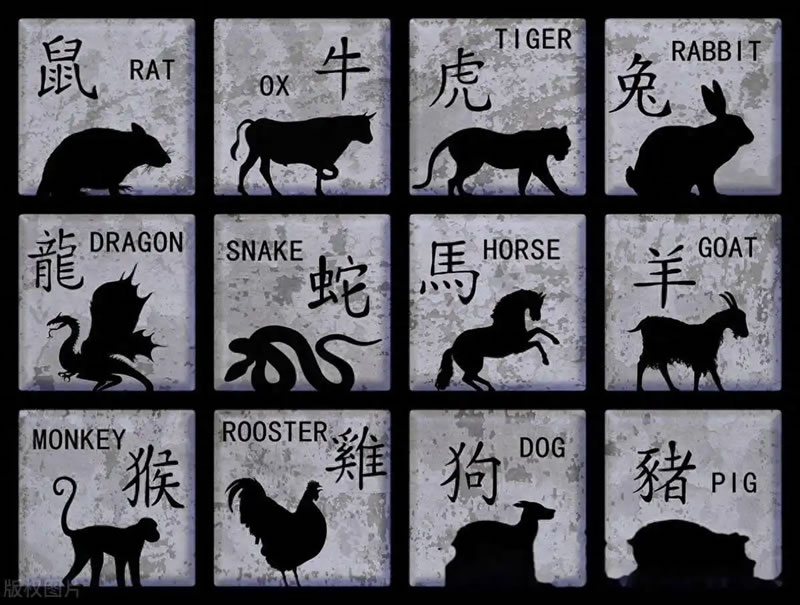How the 12 Chinese Zodiac Animals Match the 12 Traditional Hours
🐭 1. Zi Hour (11:00 PM – 1:00 AM) — Rat (Zi Rat)① Ancient Chinese noticed rats were most active at midnight (Zi hour). This linked the hour to the rat, creating “Zi Rat“①. As Zi hour starts the new day, the rat became the zodiac’s first animal. Folklore admired rats’ fertility, and since people…

🐭 1. Zi Hour (11:00 PM – 1:00 AM) — Rat (Zi Rat)①
Ancient Chinese noticed rats were most active at midnight (Zi hour). This linked the hour to the rat, creating “Zi Rat“①. As Zi hour starts the new day, the rat became the zodiac’s first animal. Folklore admired rats’ fertility, and since people wished for large families, they developed rat reverence symbolizing abundant offspring.
🐮 2. Chou Hour (1:00 AM – 3:00 AM) — Ox (Chou Ox)
As the saying goes: “A horse won’t fatten without night feed②” – same for oxen. Farmers relied on oxen for plowing, so feeding them was vital. At 1-2 AM (Chou hour), farmers fed their oxen. Thus oxen connected to Chou hour as “Chou Ox“.
🐯 3. Yin Hour (3:00 AM – 5:00 AM) — Tiger (Yin Tiger)
3-4 AM (Yin hour) is peak hunting time for nocturnal tigers. Farmers often heard roars nearby, leading to the name “Yin Tiger“.
🐰 4. Mao Hour (5:00 AM – 7:00 AM) — Rabbit (Mao Rabbit)
At dawn (Mao hour), rabbits emerge to eat dew-covered grass. This natural routine created “Mao Rabbit“.
🐉 5. Chen Hour (7:00 AM – 9:00 AM) — Dragon (Chen Dragon)③
Morning mist (Chen hour) was thought perfect for dragons③ to soar through clouds. With the rising sun’s energy, it became “Chen Dragon“③.
🐍 6. Si Hour (9:00 AM – 11:00 AM) — Snake (Si Snake)④
When sunshine replaced mist (Si hour), cold-blooded snakes emerged to bask. Hence “Si Snake“④. Notably, the ancient character “Si” (巳) was shaped like a snake④.
🐴 7. Wu Hour (11:00 AM – 1:00 PM) — Horse (Wu Horse)
The fierce noon sun (Wu hour) mirrored the fiery spirit of strong horses, humanity’s helpers. This connection birthed “Wu Horse“.
🐑 8. Wei Hour (1:00 PM – 3:00 PM) — Goat (Wei Goat)⑤
Dew-free afternoons (Wei hour) were ideal for grazing goats. Called “Wei Goat“⑤, some regions named it “Sheep Slope Time“⑤ (羊出坡).
🐵 9. Shen Hour (3:00 PM – 5:00 PM) — Monkey (Shen Monkey)
During pleasant late afternoons (Shen hour), monkeys played and chattered in trees. Their audible joy inspired “Shen Monkey“.
🐔 10. You Hour (5:00 PM – 7:00 PM) — Rooster (You Rooster)
At sunset (You hour), farmwives urgently called roosters back to coops before dark, creating “You Rooster“.
🐶 11. Xu Hour (7:00 PM – 9:00 PM) — Dog (Xu Dog)
During pre-bed checks (Xu hour), loyal dogs accompanied owners on rounds, hence “Xu Dog“.
🐷 12. Hai Hour (9:00 PM – 11:00 PM) — Pig (Hai Pig)⑥
In late-night quiet (Hai hour), owners heard pigs rooting in troughs⑥ – a welcome sound requiring extra feed for growth. Thus “Hai Pig“.
Cultural & Linguistic Notes
- ① Zi Rat: Combines time period (Zi) with zodiac animal. Represents fertility and new beginnings in Chinese culture.
- ② Horse Proverb: Traditional saying (Mǎ wú yè cǎo bù féi) stressing night feeding’s importance for livestock.
- ③ Chinese Dragon: Benevolent symbol of power and luck (different from Western dragons), written as Loong for distinction.
- ④ Si Character: Ancient Chinese character “巳” was pictographically designed as a coiled snake.
- ⑤ Sheep Slope Time: Regional term (Yáng chū pō) meaning “sheep/goats going onto slopes” for ideal grazing time.
- ⑥ Rooting: Natural pig behavior (Gǒng cáo) of nudging troughs with snouts to find food.